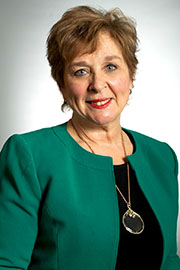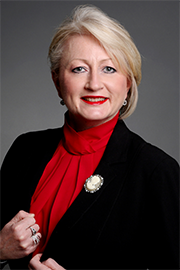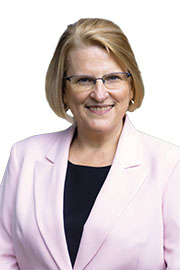- Nov/23/23 9:20:00 a.m.
- Re: Bill 135
Let me just start by thanking the Deputy Premier and Minister of Health for her work on introducing this important legislation and her dedication to strengthening our publicly funded health care system and improving home and community care for the people of Ontario no matter where they live.
With a growing and aging population and people living increasingly longer, home and community care is of vital importance for our health care system. Our seniors deserve the very best, and they deserve to be able to live comfortably with dignity at home and access health care services conveniently so they can be healthy and supported in their homes and in their community, where they want to be, close to their loved ones.
As outlined by the Minister of Health and in our recently introduced legislation, the gradual transition of home care into Ontario health teams is a fundamental part of the work we are doing to improve the home care experience for patients, for families and for caregivers, and it will improve how providers collaborate to provide care which is centred around patients.
Speaker, the proposed Convenient Care at Home Act is the latest legislation designed to improve the delivery of home care in Ontario and, if passed, would create a strong and centralized foundation for home care service delivery now and as care is delivered through our Ontario health teams in the future, enabling service provider organizations, health service providers, Ontario Health, and Ontario health teams to implement new models of home care that better connect patients and caregivers with health and other services, including from primary care, community providers, hospitals, and others. Home care would be delivered to patients in a more connected way, as new models of care are implemented and home care is delivered through Ontario health teams.
Connecting home care to other parts of the health care system through Ontario health teams will enable easier transitions for patients from one type of care to another, such as from hospital to home, and make teamwork and communication easier among providers, patients and caregivers. This will help ensure we are making the very best use of our whole health care system and all of the capacity in it.
Continuity of patient care is a foundational part of this plan. Maintaining stable home care delivery while transitioning to Ontario health teams requires careful planning and preparation. We have made significant progress already in modernizing the home care sector, achieving better patient outcomes through system integration and ensuring that our publicly funded health care system remains accessible and sustainable for future generations.
Our government is supporting modernization with significant investments to expand system capacity, including the permanent wage enhancement for personal support workers and the temporary retention initiative for nurses, plus significant funding for service expansion and for new models of care. The government is investing $1 billion over three years, which was actually expedited this year, including nearly $300 million to stabilize the home and community care workforce. This is a historic investment into home care that supports better working conditions, including compensation for travel time.
In 2020, our government introduced the Connecting People to Home and Community Care Act. This established a new framework for home and community care. This new legislative framework, alongside new home and community care regulations, took effect in 2022. The legislative framework was a first step designed to facilitate the delivery of home care by Ontario health teams and enable new models of care, including changes to care coordination.
The Connecting People to Home and Community Care Act ushered in a modernized and flexible framework for home and community care. This framework enables Ontario health teams to provide home care services as well as make it more flexible and efficient for contracted service provider organizations to coordinate and deliver care.
To build on this work, one of the first steps under the proposed Convenient Care at Home Act would be to integrate the 14 Home and Community Care Support Services organizations into a single organization called Ontario Health atHome, which would take on responsibility for coordinating all home care services across the province through Ontario health teams, under Ontario Health. Establishing one single organization will help us address the challenges in delivering home care, while promoting efficiency, stability for patients and staff, and consistency of service delivery.
Through the transition of Home and Community Care Support Services to Ontario Health atHome, staff employment and collective agreements will continue to ensure continuity for patients and staff.
Ontario Health atHome will provide critical operational supports, including care coordination supports and back-office services, to enable efficient care delivery, with Ontario health teams focused on patient-facing clinical delivery and Ontario Health atHome focused on supporting that care. Instead of different policies or processes, or separate information technology systems, one single organization will be more efficient, cutting down on administrative duplication and bureaucracy and creating a more seamless experience for patients and their families.
Ontario Health would fund and oversee the organization Ontario Health atHome, which would be a crown agency, just like the home and community care support service organizations. They would be able to align funding and oversight of home and community care, and ensure better alignment across the health care sector, while supporting convenient, connected, high-quality home and community care for patients and caregivers through our Ontario health teams.
Establishing Ontario Health atHome would also support the effective “scale and spread” of new models of care already in place in parts of the province, as well as create a platform to support consistent and equitable care delivery across Ontario health teams.
Ontario Health has proven itself with its significant experience in health system integration. Ontario Health has already successfully integrated 22 former health agencies and organizations—ranging from Cancer Care Ontario to eHealth to Health Quality Ontario—into a single streamlined organization. They have brought together the expertise and knowledge from all of these agencies to deliver a more connected and convenient health care system.
Ontario Health is also implementing our government’s Digital First for Health Strategy, and they support the Mental Health and Addictions Centre of Excellence, which is helping to implement the Roadmap to Wellness, our comprehensive mental health and addictions strategy.
Speaker, for years, there has been significant variation in access to care across the province, and this was identified as a real opportunity for improvement. All Ontarians deserve the same standard of care, no matter where they live, at every stage of their life.
Ontario’s home and community care support service organizations, which would transition to a single agency under Ontario Health called Ontario Health atHome, have also been collaborating to support more connected home care and to support Ontario health teams. Across the province, we are already seeing impactful results. Let me just give a few examples.
In Central East, a multidisciplinary mobile emergency diversion team has been established. It is made up of rapid-response nurses, occupational therapists, physiotherapists, nurse practitioners and community paramedicine providers. This multidisciplinary team assists with immediate patient care needs, like administering medications, wound care, and home safety assessments, until the contracted home care services can be secured. This temporary and urgent hands-on care allows patients to be discharged from hospital sooner, and also helps prevent a return trip to the emergency department, while helping to preserve hospital beds for those who need them most. The multidisciplinary mobile emergency team was first piloted in the Peterborough area, and it helped to divert 92 emergency department visits within just 120 days.
In Durham, Home and Community Care Support Services Central East is supporting a local Ontario health team leading project, which will deliver an integrated system of care for the residents of downtown Oshawa. The residents of this area have higher rates of chronic conditions and a higher utilization of emergency departments and community and social services compared to the regional average. With this particular project, called the downtown Oshawa neighbourhood integrated model of care, patients will be able to access care from various providers on-site at a local apartment building that is also home to a significant number of seniors facing socio-economic challenges. This integrated model of care will include on-site care coordinators, community paramedicine providers, Lakeridge mental health services, Community Care Durham, and contracted service provider organizations. Care may also be accessed through self-referrals and primary-care referrals. The patient pathway is based on the principle of “no wrong door” for services.
I saw a similar pilot in Burlington, when I went with my colleague the MPP from Burlington to visit the Burlington Ontario Health Team organization, which has a community wellness hub which has similar services.
In North Simcoe Muskoka, a stroke care coordinator role has been developed to help patients transition more easily from hospital to home after experiencing a stroke. Based out of the Royal Victoria Regional Health Centre and supported by the Central East Stroke Network, this program has helped increase the number of stroke patients admitted to the home and community care support services’ stroke pathway and supported admissions to the pathway from all of the hospitals in the area. Patients, hospitals and the community alike all benefit from this program. We have seen a reduction in hospital readmissions for stroke patients, and improved integration between home care and outpatient programs.
In Central West, the hospital-to-home direct nursing service has a dedicated team of nurses to support palliative patients through regular check-ins and symptom monitoring. These nurses assess patients and can provide appropriate patient care, which helps to prevent the need for emergency intervention. The hospital-to-home nurse completes weekly clinical assessments of the patients, their symptoms and the situation in their home, and provides education and resources to support the patient, the family or caregiver, so that the patient can remain safely in their own home, which is something that so many of our constituents tell us that they want for their families, for their friends and for their neighbours.
Home and Community Care Support Services South West has also implemented palliative care initiatives such as providing specialized education, which is enabling patients to have access to nurses with more specialized skills in palliative care and supports more patient- and family-centred end-of-life care in their place of choice: at home.
The new model of care, called @home, will ensure hospitals and health care partners are working together to deliver an integrated approach for patients, for their families and their caregivers while they transition to home from the hospital. Most patients enrolled in @home programs have been seniors who are at significant risk for re-hospitalization. Patients receive care for up to 16 weeks, after which they may transition to home and community care support services for ongoing health care and personal supports. Home and Community Care Support Services Central have supported the safe transition of hundreds of patients through recently established @home programs from five hospitals already: Humber River in Toronto, Mackenzie Health in Richmond Hill and Vaughan, Oak Valley Health in Markham-Stouffville, North York General, and Southlake in Newmarket.
Once patients are safely at home, home care providers work together to develop a plan to meet each patient’s individual needs, including services such as nursing, personal support, restorative or rehabilitation services, and medical equipment and supplies. This connected patient-centred model of care has optimized patient recovery while also helping to support and protect hospital capacity.
These are impressive accomplishments that are demonstrating, on the ground, the exciting opportunities and advantages for patients with integrated models of care. We will continue to build on this work and deliver more wins for patients and communities as we transition the home and community care support services organizations into a single agency: Ontario Health atHome.
And as local home care delivery becomes the responsibility of our Ontario health teams, there will be even more opportunities to provide integrated and effective care for patients and families, suited to their particular needs in that community. They will be part of a more connected health care system, with an integrated model of care delivery that is better structured and equipped to provide patients with faster and easier access to home and community care.
We continue to see more and more examples of the benefits of connected and integrated care, whether it is the province’s community paramedicine initiative, where paramedics work alongside home care and primary care providers to give people living with chronic health conditions additional supports to live at home more independently and prevent return visits to the emergency department, or through our expanded 911 patient care models that give paramedics flexibility to treat certain 911 patients on-scene, in their homes, or take them to a more appropriate care facility in the community rather than just an emergency room. This approach allows more people to be diverted from emergency departments, and instead receive faster and more appropriate care.
Speaker, home care is clearly a vital part of our health care sector, connecting patients to the care that they need in the comfort of their homes, while allowing the broader system to function more efficiently and serve patients better.
As our government has continued to modernize home and community care, including planning the transition of home care to Ontario health teams, we have listened carefully to and worked closely with our service provider organizations, our home care staff, patients and families, and other system partners to ensure that there is a solid foundation of care that is more seamlessly connected with other parts of our health care system and which is based on the core principle of patient-centred care.
A key part of our ongoing effort towards a modern, patient-focused model of home care is the continuity—as I said before—of patient care as we make this transition. It is essential that we avoid disruption for patients and families. And that is why our government has carefully engaged in thoughtful planning and preparation to ensure stable home care delivery is maintained. At the same time, we are making improvements to care through this program, and the gradual transition for Ontario health teams will make that happen.
The proposed Convenient Care at Home Act is critical to supporting Ontario health teams to continue to forge these relationships and these strong connections, and to better integrate home care across our health care system. Our government has taken innovative, bold and decisive action to strengthen our health care system.
After 25 years of not really much change, we are working collaboratively with our health and community partners to implement a more connected and convenient system for Ontarians, so they can get the health care they need where and when they need it. The proposed act today, the Convenient Care at Home Act, is really another step forward to ensure that Ontarians get the patient-centred care that they need and deserve.
I will now pass the rest of the time over to my colleague the MPP from Newmarket–Aurora, the other parliamentary assistant to health.
- Hear!
- Rabble!
- Hear!
- Rabble!
- Nov/23/23 9:40:00 a.m.
- Re: Bill 135
Firstly, I would like to thank the Deputy Premier and Minister of Health for her leadership as we build a stronger, more connected, publicly funded health care system for the people of Ontario—I’d also like to thank my fellow parliamentary assistant for her remarks today, for her support to the minister and for her mentorship to me on this file—a health care system that is truly patient-centred and provides convenient and connected care when and where people need it. I am proud to rise in the House today to speak to the Convenient Care at Home Act for its third reading, both representing my constituents of Newmarket–Aurora and as the parliamentary assistant to the Minister of Health.
Speaker, our government is making record investments in health care. Under the leadership of Premier Ford, we have increased the health budget by more than $16 billion since 2018. These funds have been invested to improve health care delivery and connect Ontarians to faster, more convenient care closer to home. We have made investments across the health care system to ensure that patients can receive the care they need when they need it, expanding access to primary care providers; supporting health care infrastructure and growing the health care workforce; bringing down wait times for services; reducing unnecessary emergency department visits, avoidable readmissions to hospitals and the rate of alternate level of care; improving access to mental health and addiction services, including for individuals in crisis; improving access to digital services; providing people with more connected and convenient care through Ontario health teams; and delivering better-connected care for people in their community and in their home, including improving transitions and wait times between hospital and home care.
Today, as we have the third reading of the proposed Convenient Care at Home Act, we recognize it as another important milestone in providing better home and community care in our province and in supporting Ontario health teams to deliver comprehensive, integrated care to patients, families and caregivers. If passed, the Convenient Care at Home Act will create a new organization called Ontario Health atHome, which has been spoken about today and previously.
Speaker, here in Ontario we enjoy world-class health services thanks to our incredibly skilled and dedicated health care workers. They are the pillar of our health care system and essential in supporting healthy communities. I’d like to take this moment to thank them for everything they do. We sincerely appreciate the work they do to keep Ontarians healthy and cared for.
Our government knows the status quo is not working. I know all of us as MPPs have heard time and again from patients, caregivers and their families about the barriers they face in accessing care. We have listened and we continue to listen, and we have taken bold, innovative and decisive action to transform our health care system to better focus on the needs of patients, families and caregivers, as well as better support for our health care providers.
Since 2019, we have taken concrete action to build a patient-centred health care system with the creation of the Ontario health teams, which will be further supported and empowered by the proposed Convenient Care at Home Act.
In these past few years, we have made great progress in improving the delivery of health care in the province through the establishment of the Ontario health teams. With the Connecting Care Act, which established Ontario health teams, we created a model of integrated, population health-based care delivery. Ontario health teams bring together health and community care providers to work and care for a population as one team, even across organizations or physical locations. We now have 57 Ontario health teams, established in every region of the province. This summer, we announced three new Ontario health teams in northeastern Ontario, which will better connect and coordinate care for people in communities including Chapleau, Cochrane, Iroquois Falls, Hearst, Hornepayne, Timmins, Sudbury, Espanola, Manitoulin and Elliot Lake. We are very close to the goal of full provincial coverage, ensuring that every person in Ontario has the support of an Ontario health team close to home. The Ministry of Health and Ontario Health continue to engage with providers in West Parry Sound so they can become an Ontario health team in the very near future, building on their strong foundation to integrating and improving care in their community.
We are seeing Ontario health teams have success across the province, delivering a variety of wins for patients and providers. Ontario health teams are exploring new partnerships with home care providers for more convenient and coordinated transition services.
One leader I’m very proud of is Southlake Regional Health Centre in my great riding of Newmarket–Aurora. In my community, they are a member of the Southlake Community Ontario Health Team, with their Geriatric Alternate Level of Care Reduction Program. The program ensures patients who have completed an acute-care hospital stay have a home care plan in place before they leave.
A number of Ontario health teams are developing new models of integrated home care by participating in a leading projects initiative. For example, the Guelph Wellington Ontario Health Team will implement an integrated primary care team model that integrates home and community care support service coordinators into primary care teams to bridge information gaps, enhance care quality and ensure that home care providers are dedicated members of the patient’s care team.
In Durham, the Ontario health team will implement a primary and community care hub model, using a central location to provide wraparound services for older adults, ensuring seamless transitions among services and a flexible support network including non-traditional providers to address diverse patient needs.
Ontario health teams are also enhancing access to home care and primary care services so that patients and families can get the care they need in the comfort of their homes or communities. For example, the East Toronto Health Partners Ontario Health Team has developed primary and community care response teams to support primary care providers in providing care to homebound and vulnerable seniors with unmet health or social needs.
Ontario Health will be leading next steps in the assessment of these new models so we can learn how to scale and spread these successful approaches. As these new models are replicated across the province, there will be tangible improvements to patient care and patient and family experiences.
The Ontario health team model also provides the opportunity for front-line health care professionals to expand on their great work so they can take the lead at doing what they know best: delivering excellent patient care. Ontario health teams are already transforming how people access care in their communities. And we have seen many examples of health and community providers collaborating to deliver more connected and convenient patient-centred care.
For example, the Algoma Ontario Health Team has established a Community Wellness Bus, bringing primary health care to vulnerable community members, helping to provide easier access to health and social services, improve health outcomes and reduce gaps in mental health and addictions care. Between April 2022 and March 2023, the community wellness bus had more than 5,000 visits.
Another example is a neighbourhood care team that has been established within a seniors’ housing building by the North Toronto Ontario Health Team. The neighbourhood care team provides low-income senior tenants a range of health care services, including regular blood pressure checks, foot care, access to social workers, wellness checks, and attachment to primary care.
The Middlesex London Ontario Health Team is another example. They are connecting primary care providers to on-demand video or audio phone interpretation services to enable patients to receive care in the language they are most comfortable using.
And in the north, the Noojmawing Sookatagaing Ontario Health Team has used their surgical transition projects to reduce 30-day emergency department visits by around 32%, and reduced average length of stay by 48%.
The Mid-West Toronto Ontario Health Team has a remote care monitoring program that has seen positive outcomes in supporting alternate-level-of-care patient discharges from the hospital back into the community. This program is now being spread to other Ontario health teams across the province.
Ontario health teams are continuing their efforts to improve the health care experiences and outcomes for their target patient population with strategies such as advancing digital health and virtual care initiatives, enhancing the quality of home and community care for seniors and their caregivers, creating more seamless care pathways, and making transitions between health care providers smoother for their patients.
Over time, Ontario health teams are expanding the services they provide, and they are continuing to build towards integrated care for their entire attributed population. Once the system matures, Ontario health teams will be accountable for providing a full and coordinated continuum of patient care. Through Ontario health teams, patients will experience improved access to health services, including digital health and virtual care options, better coordination and transitions in care, and better communication and information from their health care providers. And as home care services gradually shift to Ontario health teams and our government modernizes home and community care, patients will benefit from these changes.
The Convenient Care at Home Act, if passed, would establish a strong and centralized foundation for a stable home care system today and as Ontario health teams take on responsibility for home care delivery in the future. Consolidating the 14 Home and Community Care Support Services organizations into Ontario Health atHome will also enable Ontario Health to continue in its role providing funding, oversight and integration of home care with other sectors, while Ontario Health atHome would be focused on service delivery. Ontario Health atHome would be organized to obtain the benefits of having home care in a single organization, under Ontario Health, and organized to serve and be responsive to local Ontario health teams. Home care will be easier to find and navigate, and transitions from hospital to home will be more convenient, with easy-to-understand home care plans for patients and their families.
Speaker, our government continues to support and invest in Ontario health teams. And the Ministry of Health has directly invested more than $118 million to support initial development, build capacity for collaboration and implement the Ontario health team model.
Ontario health teams are also playing a pivotal role in implementing the province’s Digital First for Health Strategy because in order to have an integrated health care system, we need strong digital capabilities on the front lines of clinical care. The Ministry of Health is working closely with Ontario health teams to support digital health adoption, including the development of digital standards for virtual patient visits, digital health information exchange, online appointment booking and patient portals, while also allowing for Ontario health teams to implement digital solutions in a way that will meet local needs for years to come. Digital health gives front-line providers better access to tools and information to meet the needs of their patients and empowers those patients with more choices in how they can access health care.
Our government has allocated more than $124 million to support Ontario health teams and other health care providers to deliver digital and virtual care options so people in Ontario can easily connect with a health care worker from the comfort of their home. Digital care options can include remote care monitoring and online appointment booking, among other advancements. So far, more than 4.2 million patients have benefited from over 760 approved digital and virtual care projects. And we are measuring the success of digital projects to see their significant impact on health care delivery and to consider the opportunities for spreading and scaling initiatives to other health care teams across the province, because we know that Ontarians want to remain in their home as long as possible, surrounded by the people they know and trust.
That’s exactly why the Convenient Care at Home Act is so important. We have the opportunity to modernize the province’s home care system for future generations and better ensure people in every corner of our great province can connect with the supports and services they need for years to come, in the place where they want to be. The only thing better than having care close to home is having care in your home. If passed, this legislation will ensure just that.
- Hear!
- Rabble!
- Nov/23/23 10:00:00 a.m.
- Re: Bill 135
We didn’t need to put it in the bill because we’ve actually actioned that. Not only have we stabilized wages by first making temporary pandemic pay for PSWs permanent in previous initiatives and policies that we’ve put in place, but also, of course, through expanded access to training more PSWs across Ontario.
- Hear!
- Rabble!
- Nov/23/23 10:00:00 a.m.
- Re: Bill 135
Thank you to my colleagues for their remarks this morning. The Ontario health team in my riding of Burlington was established in 2019, and since that time, has been working together as one coordinated team to provide integrated care to the residents in my community.
I heard the member from Newmarket–Aurora talk about digital health care resources. I just wanted to let you know that the Burlington OHT has created a user-friendly app that helps link residents to health and hospital services, mental health services and palliative care, just to name a few of the options outlined that are available on their app.
I know that there are 12 Ontario health teams that are participating right now. I’m just wondering if you could tell me which other communities were chosen, besides the one in my community of Burlington.
- Hear!
- Rabble!
- Hear!
- Rabble!
- Nov/23/23 10:00:00 a.m.
- Re: Bill 135
I’d like to thank the member from Burlington for her question. And yes, we have an initial group of 12 Ontario health teams that have been chosen to accelerate their work to deliver the home care in their communities, and that will be starting in 2025. So to answer the question of the member, the 12 health teams are: the All Nation Health Partners Ontario Health Team, serving Kenora and Sioux Narrows-Nestor Falls; of course, her own Burlington Ontario health team; Cou—
- Hear!
- Rabble!
- Nov/23/23 10:00:00 a.m.
- Re: Bill 135
The Information and Privacy Commissioner, an independent and non-partisan officer, identified rampant confidentiality issues with this legislation and made a series of recommendations, all of which were declined by the government during clause-by-clause consideration. What action is this government taking to actually ensure that this bill provides any protection for patient confidentiality, recognizing that none has been identified, as written?
- Hear!
- Rabble!
- Nov/23/23 10:00:00 a.m.
- Re: Bill 135
It was interesting listening to the people who came in and did deputations. All of them agree on one thing: Our home care system is not able to recruit and retain a stable workforce. They are not able to meet the needs of the people who qualify for home care right now and who cannot gain access because the different contractors are not able to hire PSWs.
What in this bill have you got to make sure that our home care system will have enough PSWs and other staff to meet the needs of the people who presently qualify for home care and will continue to qualify for home care? We put forward the motion to make PSW jobs good jobs, permanent full-time jobs and well paid. Where in this bill do you address the number one issue in home care?
We all know that Ontario health teams will also soon be dominated by for-profit. Now that we have for-profit long-term-care homes, for-profit home and community care, many of the big players of the Ontario health teams will be for-profit. Many presenters asked to make sure that the care coordinators do not get delegated to a for-profit agency. We put amendments forward to do just that. Those were voted down.
Aren’t you afraid of the conflict of interest once a care coordinator works for a for-profit agency?
- Hear!
- Rabble!
- Nov/23/23 10:10:00 a.m.
- Re: Bill 135
Very clearly, Ontario Health atHome fails to assume the same responsibilities that the local health integration networks previously assumed. The minister implied during public hearings that she expects the hospitals to take on all the responsibilities, even through they’re not capable of doing that. What will she do to ensure that hospitals get the support that they need?
- Hear!
- Rabble!
- Nov/23/23 10:10:00 a.m.
- Re: Bill 135
While we are working through all of the details, we need to make sure that our Ontario health teams are prepared. I can appreciate the member is anxious to get this up and running in his community. We need to make sure, and that’s why we have set the 2025 date. I believe that you will see your constituents will now have a far better appreciation and understanding of what to expect as they leave hospital and go into home and community care. It won’t matter, frankly, which community they are living in; they will have a consistent approach in that transition from hospital to home.
- Hear!
- Rabble!
- Nov/23/23 10:10:00 a.m.
- Re: Bill 135
Further questions?
Third reading debate deemed adjourned.
- Hear!
- Rabble!
- Nov/23/23 10:10:00 a.m.
- Re: Bill 135
We managed to table a lot of motions and amendments to this bill in the very short period of time that we had been given, but it didn’t matter if we talked about, number one, making PSW jobs good jobs so that they can recruit and retain a stable workforce; that we talked about the conflict of interest of having care coordinators working for for-profit agencies; that we talked about the Information and Privacy Commissioner writing to us and asking us to make changes to the bill to make sure that we protect patients’ privacy; that we asked for changes to the board so that we can see what is happening with the boards of the LHINs, that we have access to their minutes, we have access to their meetings. None of this will be available once the LHINs are no longer there in Ontario Health atHome. They voted each and every one of those amendments down.
How can you ensure transparency—
I first met Patty in 2015 when she was elected as secretary-treasurer of the OFL, and she has not stopped impressing me ever since. Patty changed the OFL for the better. Her leadership style is completely different. She’s a collaborator. She brings people together to co-operate, to accomplish goals as a team. Patty is able to listen, in sometimes pretty tense situations, and hear what unites us, not what divides us. She brings together those pieces that everyone agrees on and uses them to unite allies with very different perspectives and priorities. Over the last four years under her leadership, the OFL was able to rally members towards a united labour movement.
Patty’s leadership came to the forefront last year, when this government introduced the Keeping Students in Class Act, an unconstitutional bill that was an attack on every union member, every worker, every student and every parent in this province. They won. The OFL, under Patty’s leadership, brought together workers in a united front that forced this government to step back.
I will miss you, Patty, but remember: I kept your phone number.
- Hear!
- Rabble!
- Nov/23/23 10:10:00 a.m.
Once again, it’s a pleasure for me to stand and advise the assembly of some great things happening in the riding of Essex. As we know, one of this government’s goals is to build 1.5 million homes over the next 10 years, and one of the organizations that’s going to help get to that goal is the Women’s Enterprise Skills Training, or WEST, organization.
WEST concentrates on giving skills and training women, especially women in underrepresented groups, in the skilled trades. WEST has a collaboration with another great organization called LIUNA, the Labourers’ International Union of North America Local 625. Together, WEST and LIUNA are going to help build the skills we need to build homes.
All of this is made possible in part through a generous grant given to these organizations by the government of the province of Ontario. I want to thank the great people at LIUNA and the great people at WEST, especially Rose Anguiano Hurst, who is from my hometown of Amherstburg, Ontario, for helping us help the people get the skills that we need to build 1.5 million homes over the next 10 years.
- Hear!
- Rabble!
- Nov/23/23 10:10:00 a.m.
I rise today to speak about the insidious grip of extremism in its various forms taking hold in Ontario. It casts a dangerous and hateful shadow upon the very fabric of our society: trans students bullied and assaulted at schools, Indian residential school and Holocaust deniers emboldened, Jewish-owned businesses and synagogues vandalized, Arabs wearing their keffiyehs targeted, women wearing hijabs harassed, and three generations of a London family murdered because they were Muslim by a driver radicalized by the dark web and extremely hateful rhetoric from ultra-conservative politicians.
White supremacy, with its vile ideologies, seeks to assert dominance, tearing apart the rich tapestry of our multicultural landscape. Transphobia and homophobia deny individuals the fundamental right to live authenticcally and without fear. Anti-Semitism and Islamophobia propagate hate and discrimination against religious communities, creating a climate of insecurity and prejudice.
We must combat these ideologies vehemently through legislative action, education and community engagement. Let us work together across party lines to eradicate extremism. Let us denounce and outlaw disinformation campaigns which breed misogyny, radicalization, white nationalism and domestic terrorism. Our actions today can ensure that unity and inclusivity prevail.
- Hear!
- Rabble!
- Nov/23/23 10:10:00 a.m.
- Re: Bill 135
Thank you to the minister for this legislation. It couldn’t come too soon. A lot of the calls that I received when I was working in health care were regarding access to home and community care. It was further difficult to deal with because I was dealing with two different LHINs. I’m wondering if the minister can tell us how this legislation will help with the navigation and access to home and community care.
- Hear!
- Rabble!
- Nov/23/23 10:10:00 a.m.
Speaker, this is Bullying Awareness Week. In school boards across the province, classes are taking time to discuss ways to combat bullying in schools.
The Centre for Addiction and Mental Health reports that over one in five students have reported being bullied at school. Many of us in this House have experienced bullying as children or teens or have children that have experienced it.
Bullying can take many, many forms, including physical, verbal, written or even cyberbullying these days. Typically, it’s an aggressive behaviour that repeats over and over again. The results are that children and teenagers may develop mental health challenges, social anxiety, loneliness, low self-esteem or even a physical illness, all because of bullying. They may become ashamed or discouraged to “tattle” on the bully.
To all the parents out there, please watch for signs that your child may be the victim of a bully. They may not want to go to school or join in activities. They may act differently than they normally do. They may start to lose money or personal items.
But most importantly, to the students across Ontario, please, remember that you are not alone. Tell an adult you trust. Talk to your friend or your sibling about it, or call the kids help line or text “CONNECT” to 686868. We, together, can stop bullying across Ontario.
- Hear!
- Rabble!
- Nov/23/23 10:20:00 a.m.
Today, I want to talk about the Learning Disability Awareness Month flag-raising that I went to by the Learning Disabilities Association of Sudbury. It got me thinking about my son Sam. When he was in grade 3, my son Sam hated going to school—absolutely hated it. If there was a supply teacher, it was so difficult for him because he felt stupid, and we let him stay home if the supply teacher was there for more than one day.
The thing is that Sam had a learning disability. It was undiagnosed at the time, but because of that, although he’s a very bright young man, he felt like he was stupid. It’s organizations like the Learning Disabilities Association of Sudbury that worked with my son to help with adaptations so that he could be strong and successful as a student, like they do with many students.
At the flag-raising, we had members there from Sudbury Five, the basketball team, and Sudbury Wolves, our local hockey team, and one of the members, when he spoke, said, “We all play for Sudbury.” I love how that resonates with me; the importance of “we all play for Sudbury” and that these kids with learning disabilities can be so successful—so incredibly successful—with the right adaptations, the right way of looking the things, the right way of helping them to learn the way they were designed learn.
My son Sam, many years later, now almost 26, is going to be graduating. Next year he’ll be a teacher, and he’ll have that knowledge and information going forward, reaching other kids who learn differently, just like he did.
- Hear!
- Rabble!
- Nov/23/23 10:20:00 a.m.
One of the things I get to really enjoy—I think we all should hopefully take the time to enjoy, and I trust we all do. This time of year, we, as elected officials, get to participate in our Santa Claus parades in a lot of our communities across the province.
In Sault Ste. Marie, we had our annual Santa Claus Parade that is hosted by our Rotary Club of Sault Ste. Marie this past Saturday. I had a great time participating in that. We put a float together. I want to thank my staff, Kathy, Jen and Edie, for working so hard to put it together. I want to thank my mom, Lina, and my kids, Jayden, Jackson, and Jarrett, who participated with me in walking down Queen Street in Sault Ste. Marie and handing out candy canes to thousands. I think we distributed just shy of 3,500 candy canes on Saturday.
One of the fun moments is being able to participate with your family, I find, in these parades, getting to walk up and down the streets and shake hands with the members of your community. It is a fun moment that I think we all have as elected officials. I trust so many of you enjoy that as well.
Of course, the one drawback, Mr. Speaker, as I’m sure you’ve seen your fair share of parades as well, is you never—and my kids point this out as we’re always leaving the parade route. That’s when you actually see the floats, as everybody is dismantling them along the parade route. You don’t get to see them, Mr. Speaker, but it’s fun to participate and welcome Santa Claus to town.
- Hear!
- Rabble!
- Nov/23/23 10:20:00 a.m.
Mr. Speaker, our young people in this province are all concerned for their future in this province. I have spoken to so many young people in Scarborough, and here’s what they tell me: Life is unaffordable. They have more student debt than ever, because the Conservatives cut OSAP grants. They don’t make enough to buy food, to pay rent, and pay back their student loan. They cannot move out of their parents’ homes, because the cost of rent is so high and this government has not built affordable housing.
Our young adults deserve to be able to live independent lives, but instead we’re seeing them driven to food banks. We all want a better future for our kids, but they can’t afford to thrive here anymore in Ontario. Many of them are leaving our province, abandoning Ontario because Ontario is abandoning them.
But I want the young people of our province, from Scarborough and beyond, to know I am here to always fight for them. They are our future now, and they are our future generation to come and our leaders for tomorrow.
- Hear!
- Rabble!















